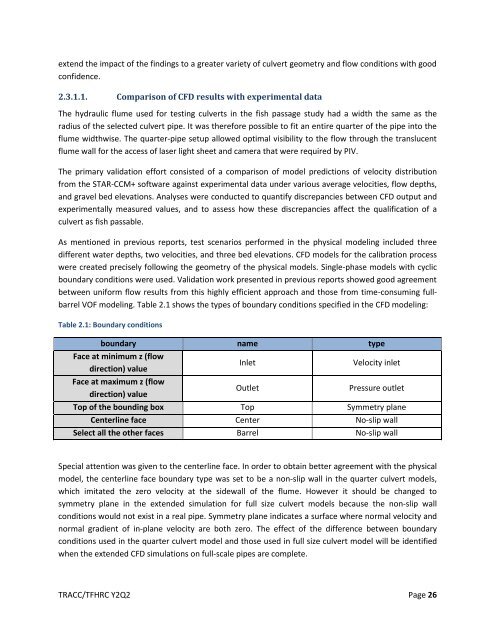Computational Mechanics Research and Support for Aerodynamics ...
Computational Mechanics Research and Support for Aerodynamics ...
Computational Mechanics Research and Support for Aerodynamics ...
- No tags were found...
You also want an ePaper? Increase the reach of your titles
YUMPU automatically turns print PDFs into web optimized ePapers that Google loves.
extend the impact of the findings to a greater variety of culvert geometry <strong>and</strong> flow conditions with good<br />
confidence.<br />
2.3.1.1. Comparison of CFD results with experimental data<br />
The hydraulic flume used <strong>for</strong> testing culverts in the fish passage study had a width the same as the<br />
radius of the selected culvert pipe. It was there<strong>for</strong>e possible to fit an entire quarter of the pipe into the<br />
flume widthwise. The quarter-pipe setup allowed optimal visibility to the flow through the translucent<br />
flume wall <strong>for</strong> the access of laser light sheet <strong>and</strong> camera that were required by PIV.<br />
The primary validation ef<strong>for</strong>t consisted of a comparison of model predictions of velocity distribution<br />
from the STAR-CCM+ software against experimental data under various average velocities, flow depths,<br />
<strong>and</strong> gravel bed elevations. Analyses were conducted to quantify discrepancies between CFD output <strong>and</strong><br />
experimentally measured values, <strong>and</strong> to assess how these discrepancies affect the qualification of a<br />
culvert as fish passable.<br />
As mentioned in previous reports, test scenarios per<strong>for</strong>med in the physical modeling included three<br />
different water depths, two velocities, <strong>and</strong> three bed elevations. CFD models <strong>for</strong> the calibration process<br />
were created precisely following the geometry of the physical models. Single-phase models with cyclic<br />
boundary conditions were used. Validation work presented in previous reports showed good agreement<br />
between uni<strong>for</strong>m flow results from this highly efficient approach <strong>and</strong> those from time-consuming fullbarrel<br />
VOF modeling. Table 2.1 shows the types of boundary conditions specified in the CFD modeling:<br />
Table 2.1: Boundary conditions<br />
boundary name type<br />
Face at minimum z (flow<br />
direction) value<br />
Face at maximum z (flow<br />
direction) value<br />
Inlet<br />
Outlet<br />
Velocity inlet<br />
Pressure outlet<br />
Top of the bounding box Top Symmetry plane<br />
Centerline face Center No-slip wall<br />
Select all the other faces Barrel No-slip wall<br />
Special attention was given to the centerline face. In order to obtain better agreement with the physical<br />
model, the centerline face boundary type was set to be a non-slip wall in the quarter culvert models,<br />
which imitated the zero velocity at the sidewall of the flume. However it should be changed to<br />
symmetry plane in the extended simulation <strong>for</strong> full size culvert models because the non-slip wall<br />
conditions would not exist in a real pipe. Symmetry plane indicates a surface where normal velocity <strong>and</strong><br />
normal gradient of in-plane velocity are both zero. The effect of the difference between boundary<br />
conditions used in the quarter culvert model <strong>and</strong> those used in full size culvert model will be identified<br />
when the extended CFD simulations on full-scale pipes are complete.<br />
TRACC/TFHRC Y2Q2 Page 26

















